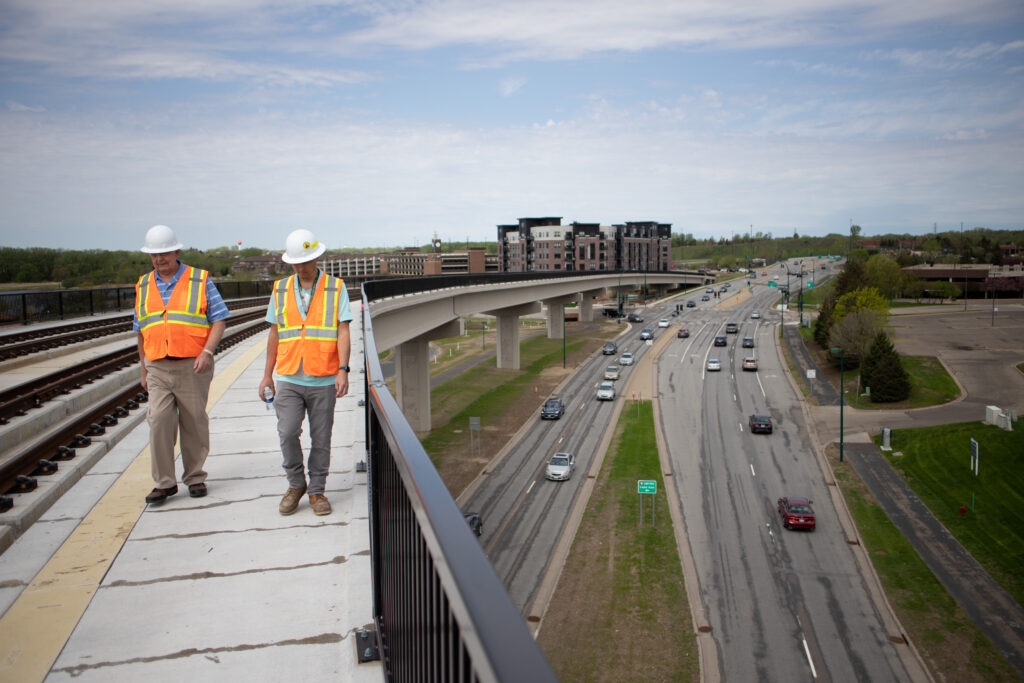Southwest Light Rail project spokesperson Trevor Roy (R) walks with a person on a bridge constructed for the light rail line during a tour. The 14.5-mile line is scheduled to open in 2027. Photo by H. Jiahong Pan/Minnesota Reformer.
The proposed plan to extend the Blue Line light rail transit through north Minneapolis has generated the usual bad-faith complaints from entrenched anti-transit interests.
The plan, which has been covered in depth by streets.mn, would provide access to the broader metro transit system to many communities with disproportionately high rates of poverty, including many still suffering the effects of systemic racism and redlining. This is particularly important because those living in impoverished communities are less likely to own cars and far more likely to rely on public transit to get around.
The group organized against the Blue Line expansion, called SLR81, has campaigned aggressively against the currently proposed route. While the organization claims to represent members from across the alignment’s path, their board and only public members live in Robbinsdale.
David Dirkers, a candidate for Robbinsdale City Council, campaigned on a similarly anti-Blue Line platform. He was unsuccessful, but it was a moot point considering the mayor and council are already opposed to the project. Consistent with the claim of SLR81, Dirkers insisted on his campaign website that he wasn’t against passenger rail per se, but merely the particulars of running light rail on the proposed alignment.
These opponents claim an openness to a bus rapid transit corridor — known as BRT — serving the area instead. Perhaps this opposition is borne of an effort to improve local transit, but experience would suggest otherwise.
For one, there really is no BRT option for the Blue Line extension. The project is already more than a decade into planning, and it relies on federal funding that would likely be forfeited if it changed transit modes this late in the game. BRT would also require an entirely new planning and environmental review process, which would take up yet more money and time. With the project already delayed until 2030, who knows how many years a switch to BRT would add.
Although it’s possible SLR81 doesn’t know the basics of large infrastructure funding, what seems more likely is that their purported support for BRT is only a way to apply a veneer of progressivism to what is in effect an anti-transit group. The fact that a switch to BRT would torpedo the entire project is more likely a feature than a bug of their proposal.
Unfortunately, we don’t have to look much further to see similarly bad-faith criticisms of the Blue Line project. The Star Tribune credulously covered complaints from the Minneapolis Park Board over a proposed at-grade crossing at the Lowry Station, burying the lede that the board had already rejected a proposed elevated crossing. To maintain an ounce of credibility after saying ‘no’ to both realistic options, the board instead proposed a third option — a tunnel, which even supporters admit would add “a billion dollars to the price tag.”
In both instances, we see opponents of the Blue Line use a similar playbook: claim to support transit while proposing unworkable alternatives, and then say ‘no’ to whatever gets put in front of them.
Opponents are also taking advantage of a recent backlash to improving car-free commuting in the Twin Cities. The Southwest LRT project’s many delays and heavily publicized cost overruns seem to have socked enthusiasm from transit support. While that project is not without its flaws — its route fails to hit major pockets of density — it was also held up for years, once again by an obstinate Minneapolis Parks Board. Media outlets breathlessly scrawled big numbers in their headlines without mentioning the billions spent each year maintaining and often expanding our road system. The shift in statewide sentiment commanded by this reporting has real impacts. We saw legislation proposed to freeze funding for future LRT projects in the Legislature just last year.
As a metro we are falling behind on transit. The time frame for funding and planning these projects is long, so while we might not feel it immediately, the current transit backlash will haunt us in the decades to come — if we fail to act now. After the Blue Line extension is completed, we will be in a drought of transit projects unless we start working today. The recent collapse of the Riverview Corridor plan, which would have connected St. Paul to the airport, is another big red flag for transit. Opposition by the Star Tribune editorial board certainly didn’t help, but the project faced setbacks and snares from its inception. The area of the most growth in our transit network has been BRT, but the northrunning Purple Line out of St. Paul is itself mired in controversy, further confirmation that even bus routes face fierce opposition. In fact, BRT’s loose definitions make it easier to strip dedicated lanes, station improvements and other key features from projects without technically abandoning them, a pattern we have seen in many local projects.
News outlets should be more skeptical of bad-faith opposition to infrastructure projects. They should ask important questions about price and ecological impact, but should also contextualize these costs with the “no-build” option, e.g., the cost of unmitigated car reliance, which drains our city budgets and pollutes our air.
We can educate our local representatives to make sure they know that sustainable transportation is a critical aspect of our fight against climate change.
And when folks make a fuss about this or that aspect of a given project, keep in the back of your mind the possibility that they may just be talking to take up our time.

